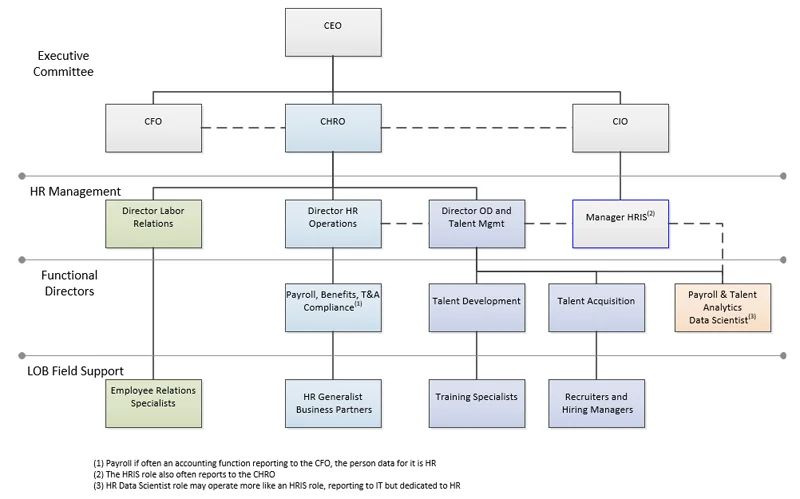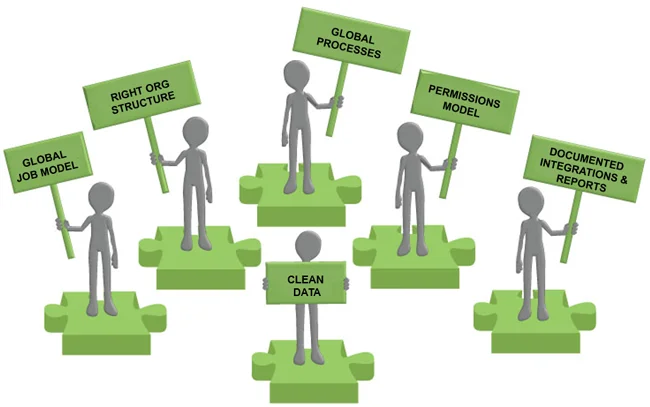HR Digital Transformation - A Business State of Mind (Part 6 of 6)
There is no better time for an HR organization to re-think its role and staffing model than when implementing an advanced digital technology.
I am often asked about what roles make up a digitally thinking HR Organization. A few years back, I drafted the diagram below for a customer. As far as roles go, I have only updated one role name, which is the Data Scientist. Other than that, in a very simple model, not much has changed functionally for over a decade. Of course, in small organizations, one person may play multiple roles, and in very large organizations, some roles may be further subdivided. But generally, the diagram is presented along with functional responsibilities.

What the diagram does not reflect is that all roles need to be owned by persons who think digitally. From the CEO to the CHRO and all functional levels, all HR organization employees need to be reasonably tech-savvy. They need to be at ease with using not only desktop computers but also mobile devices. They need to embrace technology and be partners to the business and technology advisors to those in the company who are less savvy. If not, then there is a risk that tech-savvy users in the company will have less respect for HR and more likely to thwart processes with workarounds or non-compliance.
There is no better time for an HR organization to re-think its role and staffing model than when implementing advanced digital technology.
Get ready before you start the implementation phase of the technology
After more than 1,000 HR technology implementation projects over the past 15 years, I am convinced that the number one reason why the projects fail as often as they succeed, is “Readiness.” Whether moving from manual or legacy technology, being ready for the change is key to success.
I have boiled this down to six key categories of readiness. These six categories are technology agnostic but are best suited to contemporary highly digitalized process solutions, primarily Cloud-based with a modern Web / Mobile user interface (UI).

They are:
There is a threshold of advancement that when reached, the ability to keep up with technology advances will be much easier than if delayed.
- HR Organization Structure – This may be the most important, which was discussed earlier in this segment. Align the HR Organization and Project Team structure for the technology and digital transformation. Ensure you have the right and adequate resources in the right roles. This is critically important to support the solution after Go-live.
- Global Job Model – Must have a suitable job structure ready to support the effort, so it will be possible to implement the application in a reasonable amount of time with a job structure that is advantageous for the selected technology but also aligned with the business. This will accelerate the project, reduce implementation costs, lower risks and increase the quality of the outcome.
- Global Digital Business Processes – Should have global business processes in place that are highly efficient and suitable to leverage the digital application BEFORE you begin configuration. Try to achieve 80% global to 20% local.
- Permission Model – Items 2 and 3 are typically required for a practical permissions model to control and maintain the new processes, based on the Organization and Job structure. A sound model will maintain the integrity and efficiency of the processes.
- Integration and Reporting – Know and thoroughly document the integrations and reports needed to support the new solution. Conduct a WRICEF (Workflow, Reporting, Interfaces, Conversion, Enhancements, and Forms) analysis early and determine all integration platforms/methods used for each interface. This is critical to success.
- Data – Develop a detailed plan for the migration of historical data. Consider data migration tools to assess the quality of the data and what data cleansing or homogenization is required. This is one of the most important time savers and budget control items.
Rightsizing the project
The recommendation is that once you have project approval, start the readiness program. This can be done while you are evaluating technology vendors or immediately after selection, but at least 4 to 6 months BEFORE you kick off the technology implementation phase when the costs rapidly accumulate.
Always do the HR organization self-assessment first. If personnel changes are required, as much time as possible is needed to get the project team in place. As always, seek an external advisor experienced in the program.
The fact is, HR will often not have the resources they truly need for the proposed digital transformation project. It was Secretary of Defense under President George W. Bush, Donald Rumsfeld, during the Iraq war who said, “As you know, you go toward with the army you have, not the army you might want or wish to have at a later time.” It’s a reality we must accept. However, rather than risk failure for the larger project, take smaller steps that are the best combination of business value and smartest leverage of the team resources available.
For example, the available team may be under-resourced to tackle a core HR transformation, but is well staffed with an excellent training team and leader. So maybe a Learning Management System (LMS) would be the better first choice. This is why an early self-assessment of the proposed project team members is so important.
Get the business READY for the project BEFORE it begins. There are 6 things to do, even before the product is acquired and the implementation project starts.
At my current company, I led a team that developed a program to address the six categories. We developed tools and accelerators to facilitate the effort. I plan to dedicate an upcoming article that will explore this program in more detail.
Summary
Business decisions are made by persons paid to make them. They involve an evaluation of Alignment, ROI, and Risk. Too often, the C-level executives are not equipped to make digital transformation decisions that significantly impact the success of the business and need to rely on their executive staff and external consultants for advice. One of these is HCM technology, which I have experienced is often underestimated for its ability to positively improve business operations and advance business results. As a result, HR projects are not given the attention and support they deserve. So, it is even more imperative that the CHRO is a driver of digital change, able to articulate a vision that is aligned with the business and focused on ROI and Risk Management.
From my POV, there are a lot of amazing things happening in technology, and, I for one, want to be part of that journey, rather than languish among those resistant to change who will still benefit from it, but not influence it. You don’t have to be the pioneer to be an influencer but be willing to adopt what the pioneers are inventing to avoid extinction. Businesses know this, and they know how to evaluate and measure ROI as well as risk in order to adopt new technology. And because they do this as a standard course for every department, HR leadership must also take up this task for HR.
The HR team can adapt and change and embrace the technology. They just may need to be pushed a little. That is Digital Leadership and that is Thinking Digitally!
These same leaders also know that the organizational model of the past will hold the company back unless they change.
For Example, the founder and Chairman of SAP, Hasso Plattner, insists that SAP needs to transform if it doesn't want to fall behind. "There are cultural changes coming," Mr. Plattner said at an SAP-organized event in Orlando, Florida in May 2019. "We have to change how we work, and we have to use new talent." This may explain why there's been a recent exodus of several top managers, most of them 20 plus-year company veterans, and SAP has offered voluntary leave and early retirement packages to some 4,400 staff, a watershed moment at a company that has been a stable employer for decades. SAP demonstrates that change is arguably less painful than failure to act.
My final view on HR organizational change is that team members are never too old to adopt technologies. My 86-year-old mother recently learned how to text on an iPhone, and it has opened a whole new world to her (which is unfortunate for me, since I am constantly bombarded with questions!).
The point is, the HR team can adapt and change and embrace the technology. They may need to be pushed a little. That is Digital Leadership, and that is Thinking Digitally!
This is the final segment in my HR Digital Transformation Series. There is much that I did not cover and weeds that I did not get into. However, I hope it has been thought-provoking, and I hope it has been informative!
I do plan to continue to comment on the subject and the technology as it evolves. I do expect that I will be asked about specific market solutions, but I decided not to comment on any vendor products in this series. I thought it would be prudent to keep that view vendor agnostic to get the word out.
However, I do have an opinion and may comment in future writings.
I look forward to your comments and extensions of this discussion. I am sure I will learn something from the feedback.
About Author
Steve Bradley is Former VP and Director for the Cloud HCM Practice at Birlasoft. He has over 20 years of HCM technology experience – and founder of two HR service companies, SystemLink and Learn2Perform. He is a frequent speaker at conference events and advisor to organizations of all sizes on the topic of HR Digital Transformation, HCM Technology and HR Organizational Change in a technology age.
